A New Look into the South America Precipitation Regimes: Observation and Forecast
Abstract
1. Introduction
2. Materials and Methods
2.1. Study Area
2.2. Data
2.2.1. ECMWF-SEAS5
2.2.2. CPC and ERA5 Data
2.3. Cluster Analysis
- (1)
- Compute the centroids for each cluster;
- (2)
- Group the elements according to the most similar centroid;
- (3)
- Recalculate the centroid for each cluster that receives the new element and for the cluster that loses the element;
- (4)
- Repeat steps 2 and 3 until all elements converge.
- (1)
- Calculations of precipitation monthly means between January and December (1993–2016) derived from daily CPC data and predictions of daily accumulated rainfall for the 1-month lead time of ECMWF-SEAS5 seasonal climate forecasts;
- (2)
- Organization of the data giving a matrix of 1581 grid points per 12 months;
- (3)
- Application of the Elbow method and its derivation proposed by Zhang et al. [107];
- (4)
- Execution of the K-means algorithm through the Scikit-Learn library from the Python language [110].
3. Results and Discussion
3.1. Elbow Method
3.2. Climatological Features
3.3. Regional Precipitation Clusters in South America
3.3.1. Cluster 1—Region 1 (R1)
3.3.2. Cluster 2—Region 2 (R2)
3.3.3. Cluster 3—Region R3 (R3)
3.3.4. Cluster 4—Region 4 (R4)
3.3.5. Cluster 5—Region 5 (R5)
3.3.6. Cluster 6—Region 6 (R6)
3.3.7. Cluster 7—Region 7 (R7)
3.3.8. Cluster 8—Region 8 (R8)
4. Conclusions
Author Contributions
Funding
Institutional Review Board Statement
Informed Consent Statement
Data Availability Statement
Acknowledgments
Conflicts of Interest
References
- Reboita, M.S.; Gan, M.A.; da Rocha, R.P.; Ambrizzi, T. Regimes de precipitação na América do Sul: Uma revisão bibliográfica. Rev. Bras. Meteorol. 2010, 25, 185–204. [Google Scholar] [CrossRef]
- Espinoza, J.C.; Garreaud, R.; Poveda, G.; Arias, P.A.; Molina-Carpio, J.; Masiokas, M.; Viale, M.; Scaff, L. Hydroclimate of the Andes part I: Main climatic features. Front. Earth Sci. 2020, 8, 64. [Google Scholar] [CrossRef]
- Arias, P.A.; Garreaud, R.; Poveda, G.; Espinoza, J.C.; Molina-Carpio, J.; Masiokas, M.; Viale, M.; Scaff, L.; van Oevelen, P.J. Hydroclimate of the Andes part II: Hydroclimate variability and sub-continental patterns. Front. Earth Sci. 2021, 8, 505467. [Google Scholar] [CrossRef]
- Kaser, G. A review of the modern fluctuations of tropical glaciers. Glob. Planet. Chang. 1999, 22, 93–103. [Google Scholar] [CrossRef]
- Rebatel, A.; Francou, B.; Soruco, A.; Gomez, J.; Cáceres, B.; Ceballos, J.L.; Basantes, R.; Vuille, M.; Sicart, J.-E.; Huggel, C.; et al. Current state of glaciers in the tropical Andes: A multi-century perspective on glacier evolution and climate change. Cryosphere 2013, 7, 81–102. [Google Scholar] [CrossRef]
- Schoolmeester, T.; Johansen, K.S.; Alfhtan, B.; Baker, E.; Hesping, M.; Verbist, K. The Andean Glacier and Water Atlas-the Impact of Glacier Retreat on Water Resources; UNESCO and GRID-Arendal: Arendal, Norway, 2018; Volume 80. [Google Scholar]
- Vuille, M.; Francou, B.; Wagnon, P.; Juen, I.; Kaser, G.; Mark, B.G.; Bradley, R.S. Climate change and tropical Andean glaciers: Past, present and future. Earth-Sci. Rev. 2008, 89, 79–86. [Google Scholar] [CrossRef]
- Barros, A.; Monz, C.; Pickering, C. Is tourism damaging ecosystems in the Andes? Current knowledge and an agenda for future research. AMBIO 2015, 44, 82–98. [Google Scholar] [CrossRef]
- Kronenberg, M.; Schauwecker, S.; Huggel, C.; Salzmann, N.; Drenkhan, F.; Frey, H.; Giráldez, C.; Gurgiser, W.; Kaser, G.; Juen, I.; et al. The projected precipitation reduction over the Central Andes may severely affect Peruvian glaciers and hydropower production. Energy Procedia 2016, 97, 270–277. [Google Scholar] [CrossRef][Green Version]
- Cook, S.J.; Kougkoulos, J.; Edwards, L.A.; Dortch, J.; Hoffmann, D. Glacier change and glacial lake outburst flood risk in the Bolivian Andes. Cryosphere 2016, 10, 2399–2413. [Google Scholar] [CrossRef]
- Veettil, B.J.; Kamp, U. Global disappearance of tropical mountain glaciers: Observations, causes and challenges. Geosciences 2019, 9, 196. [Google Scholar] [CrossRef]
- Yarleque, C.; Vuille, M.; Hardy, D.R.; Timm, O.E.; de la Cruz, J.; Ramos, H.; Rabatel, A. Projections of the future disappearance of the Quelccaya Ice Cap in the Central Andes. Sci. Rep. 2018, 8, 15564. [Google Scholar] [CrossRef]
- Masiokas, M.H.; Rabatel, A.; Rivera, A.; Ruiz, L.; Pitte, P.; Ceballos, J.L.; Barcaza, G.; Soruco, A.; Bown, F.; Berthier, E.; et al. A review of the current state and recent changes of the Andean cryosphere. Front. Earth Sci. 2020, 8, 99. [Google Scholar] [CrossRef]
- Poveda, G.; Espinoza, J.C.; Zuluaga, M.D.; Solman, S.A.; Garreaud, R.; van Oevelen, P.J. High impact weather events in the Andes. Front. Earth Sci. 2020, 8, 162. [Google Scholar] [CrossRef]
- Almazroui, M.; Ashfaq, M.; Islam, M.N.; Kamil, S.; Abid, M.A.; O’Brien, E.; Ismail, M.; Reboita, M.S.; Sörensson, A.A.; Arias, P.A.; et al. Assessment of CMIP6 performance and projected temperature and precipitation changes over South America. Earth Syst. Environ. 2021, 5, 155–183. [Google Scholar] [CrossRef]
- Wang, X.-Y.; Li, X.; Zhu, J.; Tanajura, C.A.S. The strengthening of Amazonian precipitation during the wet season driven by tropical sea surface temperature forcing. Environ. Res. Lett. 2018, 13, 094015. [Google Scholar] [CrossRef]
- Phillips, O.L.; Brienen, R.J.W. Carbon uptake by mature Amazon forests has mitigated Amazon nations’ car emissions. Carbon Balance Manag. 2017, 12, 1. [Google Scholar] [CrossRef]
- Baudena, M.; Tuinenberg, O.A.; Ferdinand, P.A.; Staal, A. Effects of land-use change in the Amazon on precipitation are likely underestimated. Glob. Chang. Biol. 2021, 27, 5580–5587. [Google Scholar] [CrossRef]
- Ter Steege, H.; Pitman, N.C.A.; Sabatier, D.; Baraloto, C.; Salomão, R.P.; Guevara, J.E.; Phillips, O.L.; Castilho, C.V.; Magnusson, W.E.; Molino, J.-F.; et al. Hyperdominance in the Amazonian tree flora. Science 2013, 342, 1243092. [Google Scholar] [CrossRef]
- Gorenflo, L.J.; Romaine, S.; Mittermeier, R.A.; Walker-Painemilla, K. Co-occurrence of linguistic and biological diversity in biodiversity hotspots and high biodiversity wilderness areas. Proc. Natl. Acad. Sci. USA 2012, 109, 8032–8037. [Google Scholar] [CrossRef]
- Marengo, J.A.; Nobre, C.A.; Sampaio, G.; Salazar, L.F.; Borma, L.S. Climate change in the Amazon Basin: Tipping points, changes in extremes, and impacts on natural and human systems. In Tropical Rainforest Responses to Climatic Change, 2nd ed.; Bush, M.B., Flenley, J.R., Gosling, W.D., Eds.; Springer Praxis Books: Berlin, Germany, 2011; pp. 259–283. [Google Scholar] [CrossRef]
- Wiltshire, A.J.; von Randow, C.; Rosan, T.M.; Tejada, G.; Castro, A.A. Understanding the role of land-use emissions in achieving the Brazilian nationally determined contribution to mitigate climate change. Clim. Resil. Sustain. 2022, 1, e31. [Google Scholar] [CrossRef]
- Barlow, J.; Berenguer, E.; Carmenta, R.; França, F. Clarifying Amazonia’s burning crisis. Glob. Chang. Biol. 2020, 26, 319–321. [Google Scholar] [CrossRef]
- Lovejoy, T.E.; Nobre, C. Amazon tipping point: Last chance for action. Sci. Adv. 2019, 5, eaba2949. [Google Scholar] [CrossRef] [PubMed]
- Bastos Lima, M.G.; Harring, N.; Jagers, S.C.; Löfgren, A.; Persson, U.M.; Sjöstedt, M.; Brülde, B.; Langlet, D.; Steffen, W.; Alpízar, F. Large-scale collective action to avoid an Amazon tipping point-key actors and interventions. CRSUST 2021, 3, 100048. [Google Scholar] [CrossRef]
- Stark, S.C.; Breshears, D.D.; Aragón, S.; Villegas, J.C.; Law, D.J.; Smith, M.N.; Minor, D.M.; Assis, R.L.; Almeida, D.R.A.; Oliveira, G.; et al. Reframing tropical savannization: Linking changes in canopy structure to energy balance alterations that impact climate. Ecosphere 2020, 11, e03231. [Google Scholar] [CrossRef]
- Boulton, C.A.; Lenton, T.M.; Boers, N. Pronounced loss of Amazon rainforest resilience since the early 2000s. Nat. Clim. Chang. 2022, 12, 271–278. [Google Scholar] [CrossRef]
- Beck, H.E.; Zimmermann, N.E.; McVicar, T.R.; Vergopolan, N.; Berg, A.; Wood, E.F. Present and future Köppen-Geiger climate classification maps at 1-km resolution. Sci. Data 2018, 5, 180214. [Google Scholar] [CrossRef]
- Mejía, J.F.; Yepes, J.; Henao, J.J.; Poveda, G.; Zuluaga, M.D.; Raymond, D.J.; Fuchs-Stone, Z. Towards a mechanistic understanding of precipitation over the far eastern tropical Pacific and western Colombia, one of the rainiest spots on Earth. J. Geophys. Res. Atmos. 2021, 126, e2020JD033415. [Google Scholar] [CrossRef]
- Böhm, C.; Reyers, M.; Schween, J.H.; Crewell, S. Water vapor variability in the Atacama Desert during the 20th century. Glob. Environ. Chang. 2020, 190, 103192. [Google Scholar] [CrossRef]
- González-Pinilla, F.J.; Latorre, C.; Rojas, M.; Houston, J.; Rocuant, M.I.; Maldonado, A.; Santoro, C.M.; Quade, J.; Betancourt, J.L. High and low-latitude forcings drive Atacama Desert rainfall variations over the past 16,000 years. Sci. Adv. 2021, 7, eabg1333. [Google Scholar] [CrossRef]
- Reboita, M.S.; Rodrigues, M.; Armando, R.P.; Freitas, C.; Martins, D.; Miller, G. Causas da semiaridez do sertão nordestino. Rev. Bras. Climatol. 2016, 19, 254–277. [Google Scholar] [CrossRef]
- Marengo, J.A.; Alves, L.M.; Álvala, R.C.S.; Cunha, A.P.; Brito, S.; Moraes, O.L.L. Climatic characteristics of the 2010-2016 drought in the semiarid Northeast Brazil region. An. Acad. Bras. Cienc. 2018, 90, 1973–1985. [Google Scholar] [CrossRef] [PubMed]
- Marengo, J.A.; Cunha, A.P.M.A.; Nobre, C.A.; Ribeiro Neto, G.G.; Magalhaes, A.R.; Torres, R.R.; Sampaio, G.; Alexandre, F.; Alvez, L.M.; Cuartas, L.A.; et al. Assessing drought in the drylands of northeast Brazil under regional warming exceeding 4 °C. Nat. Hazards 2020, 103, 2589–2611. [Google Scholar] [CrossRef]
- Kodama, Y. Large-scale common features of subtropical precipitation zones (the Baiu Frontal zone, the SPCZ, and the SACZ). Part I: Characteristics of subtropical frontal zones. J. Meteorol. Soc. Jpn. 1992, 70, 581–610. [Google Scholar] [CrossRef]
- Liebmann, B.; Marengo, J.A. Interannual variability of the rainy season and rainfall in the Brazilian Amazon Basin. J. Clim. 2001, 14, 4308–4318. [Google Scholar] [CrossRef]
- Carvalho, L.M.V.; Jones, C.; Liebmann, B. Extreme precipitation events in southeastern South America and large-scale convective patterns in the South Atlantic Convergence Zone. J. Clim. 2002, 15, 2377–2394. [Google Scholar] [CrossRef]
- Carvalho, L.M.V.; Jones, C.; Liebmann, B. The South Atlantic Convergence Zone: Intensity, form, persistence, and relationships with intraseasonal to interannual activity and extreme rainfall. J. Clim. 2004, 17, 88–108. [Google Scholar] [CrossRef]
- Vera, C.; Higgins, W.; Amador, J.; Ambrizzi, T.; Garreaud, R.; Gochis, D.; Gutzler, D.; Lettenmaier, D.; Marengo, J.A.; Mechoso, C.R.; et al. Toward a unified view of the American Monsoon Systems. J. Clim. 2006, 19, 4977–5000. [Google Scholar] [CrossRef]
- Wang, B.; Ding, Q. Global monsoon: Dominant mode of annual variation in the tropics. Dyn. Atmos. Oceans. 2008, 44, 165–183. [Google Scholar] [CrossRef]
- Bombardi, R.J.; Carvalho, L.M.V. IPCC global Coupled model simulations of the South America monsoon system. Clim. Dyn. 2009, 33, 893–916. [Google Scholar] [CrossRef]
- Marengo, J.A.; Liebmann, B.; Grimm, A.M.; Misra, V.; Silva Dias, P.L.; Cavalcanti, I.F.A.; Carvalho, L.M.V.; Berbery, E.H.; Ambrizzi, T.; Vera, C.S.; et al. Recent developments on the South American monsoon system. Int. J. Climatol. 2012, 32, 1–21. [Google Scholar] [CrossRef]
- Wang, B.; Liu, J.; Kim, H.-J.; Webster, P.J.; Yim, S.-Y. Recent change of the global monsoon precipitation (1979–2008). Clim. Dyn. 2012, 39, 1123–1135. [Google Scholar] [CrossRef]
- Carvalho, L.M.V.; Cavalcanti, I.F.A. The South American Monsoon System (SAMS). In The Monsoons and Climate Change, 1st ed.; Carvalho, L.M.V., Jones, C., Eds.; Springer: Sydney, Australia, 2016; pp. 121–148. [Google Scholar]
- Grimm, A.M. South American monsoon and its extremes. In Tropical Extremes-Natural Variability and Trends, 1st ed.; Venugopal, V., Sukhatme, J., Murtugudde, R., Roca, R., Eds.; Elsevier: Amsterdam, Netherlands, 2019; pp. 51–93. [Google Scholar] [CrossRef]
- Pascale, S.; Carvalho, L.M.V.; Adams, D.K.; Castro, C.L.; Cavalcanti, I.F.A. Current and future variations of the monsoons of the Americas in a warming climate. Curr. Clim. Chang. Rep. 2019, 5, 125–144. [Google Scholar] [CrossRef]
- Wang, B.; Jin, C.; Liu, J. Understanding future change of global monsoons projected by CMIP6 models. J. Clim. 2020, 33, 6471–6489. [Google Scholar] [CrossRef]
- Sena, A.C.T.; Magnusdottir, G. Projected end-of-century changes in the South American Monsoon in the CESM large ensemble. J. Clim. 2020, 33, 7859–7874. [Google Scholar] [CrossRef]
- Ashfaq, M.; Cavazos, T.; Reboita, M.S.; Torres-Alavez, J.A.; Im, E.-S.; Olusegun, C.F.; Alves, L.; Key, K.; Adeniyi, M.O.; Tall, M.; et al. Robust late twenty-first century shift in the regional monsoons in RegCM-CORDEX simulations. Clim. Dyn. 2021, 57, 1463–1488. [Google Scholar] [CrossRef]
- Correa, I.C.; Arias, P.A.; Rojas, M. Evaluation of multiple indices of the South American monsoon. Int. J. Climatol. 2021, 41, E2801–E2819. [Google Scholar] [CrossRef]
- Teodoro, T.A.; Reboita, M.S.; Llopart, M.; da Rocha, R.P.; Ashfaq, M. Climate change impacts on the South American Monsoon System and its surface-atmosphere processes through RegCM4 CORDEX-CORE projections. Earth Syst. Environ. 2021, 5, 825–847. [Google Scholar] [CrossRef]
- Reboita, M.S.; Teodoro, T.A.; Ferreira, G.W.S.; Souza, C.A. Ciclo de vida do sistema de monção da América do Sul: Clima presente e futuro. Rev. Bras. Geogr. Fis. 2022, 15, 343–358. [Google Scholar] [CrossRef]
- Ramage, C.S. Monsoon Meteorology, 1st ed.; Academic Press: New York, NY, USA, 1971. [Google Scholar]
- Zhou, J.; Lau, K.M. Does a monsoon climate exist over South America? J. Clim. 1998, 11, 1020–1040. [Google Scholar] [CrossRef]
- Marengo, J.A.; Liebmann, B.; Kousky, V.E.; Filizola, N.P.; Wainer, I.C. Onset and end of the rainy season in the Brazilian Amazon Basin. J. Clim. 2001, 14, 833–852. [Google Scholar] [CrossRef]
- Durán-Quesada, A.M.; Reboita, M.S.; Gimeno, L. Precipitation in tropical America and the associated sources of moisture: A short review. Hydrol. Sci. J. 2012, 57, 612–624. [Google Scholar] [CrossRef]
- Virji, H. A preliminary study of summertime tropospheric circulation patterns over South America estimated from cloud winds. Mon. Weather Rev. 1981, 109, 599–610. [Google Scholar] [CrossRef]
- Lenters, J.D.; Cook, K.H. On the origin of the Bolivian High and related circulation features of the South American climate. J. Atmos. Sci. 1997, 54, 656–678. [Google Scholar] [CrossRef]
- Escobar, G.C.J. Classificação sinótica durante a estação chuvosa do Brasil. Anu. Inst. Geocienc. 2019, 42, 421–436. [Google Scholar] [CrossRef]
- Seluchi, M.E.; Saulo, A.E. Baixa do noroeste argentino e Baixa do Chaco: Características, diferenças e semelhanças. Rev. Bras. Meteorol. 2012, 27, 49–60. [Google Scholar] [CrossRef]
- Santos, D.F.; Reboita, M.S. Jatos de baixos níveis a leste dos Andes: Comparação entre duas reanálises. Rev. Bras. Climatol. 2018, 22, 423–445. [Google Scholar] [CrossRef]
- Montini, T.L.; Jones, C.; Carvalho, L.M.V. The South American low-level jet: A new climatology, variability and changes. J. Geophys. Res. Atmos. 2019, 124, 1200–1218. [Google Scholar] [CrossRef]
- Reboita, M.S.; Ambrizzi, T.; Silva, B.A.; Pinheiro, R.F.; da Rocha, R.P. The South Atlantic Subtropical Anticyclone: Present and future climate. Front. Earth Sci. 2019, 7, 8. [Google Scholar] [CrossRef]
- Kousky, V.E. Pentad outgoing longwave climatology for the South American sector. Rev. Bras. Meteorol. 1988, 3, 217–231. [Google Scholar]
- Silva, J.P.R.; Reboita, M.S.; Escobar, G.C.J. Caracterização da Zona de Convergência do Atlântico Sul em campos atmosféricos recentes. Rev. Bras. Climatol. 2019, 25, 355–377. [Google Scholar] [CrossRef]
- Escobar, G.C.J.; Reboita, M.S. Relationship between daily atmospheric circulation patterns and South Atlantic Convergence Zone (SACZ) events. Atmósfera 2022, 35, 1–25. [Google Scholar] [CrossRef]
- Llopart, M.; Reboita, M.S.; da Rocha, R.P. Assessment of multi-model climate projections of water resources over South America CORDEX domain. Clim. Dyn. 2020, 54, 99–116. [Google Scholar] [CrossRef]
- Junquas, C.; Li, L.; Vera, C.S.; Le Treut, H.; Takahashi, K. Influence of South America orography on summertime precipitation in southeastern South America. Clim. Dyn. 2016, 46, 3941–3963. [Google Scholar] [CrossRef]
- Zazulie, N.; Rusticucci, M.; Raga, G.B. Regional climate of the subtropical Central Andes using high-resolution CMIP5 models. Part II: Future projections for the twenty-first century. Clim. Dyn. 2017, 51, 2913–2925. [Google Scholar] [CrossRef]
- Rivera, J.A.; Arnould, G. Evaluation of the ability of CMIP6 models to simulate precipitation over Southwestern South America: Climatic features and long-term trends (1901–2014). Atmos. Res. 2020, 241, 104953. [Google Scholar] [CrossRef]
- Arias, P.A.; Ortega, G.; Villegas, L.D.; Martínez, J.A. Colombian climatology in CMIP5/CMIP6 models: Persistent biases and improvements. Rev. Fac. Ing. 2021, 100, 75–96. [Google Scholar] [CrossRef]
- Kuki, C.A.C.; Ferreira, G.W.S.; Reboita, M.S. Avaliação da performance da previsão sazonal para o Brasil utilizando o CFSv2 e ECMWF-SEAS5. Rev. Bras. Climatol. 2021, 29, 385–413. [Google Scholar] [CrossRef]
- Ortega, G.; Arias, P.A.; Villegas, J.C.; Marquet, P.A.; Nobre, P. Present-day and future climate over Central and South America according to CMIP5/CMIP6 models. Int. J. Climatol. 2021, 41, 6713–6735. [Google Scholar] [CrossRef]
- Dias, C.G.; Reboita, M.S. Assessment of CMIP6 simulations over tropical South America. Rev. Bras. Geogr. Fis. 2021, 14, 1282–1295. [Google Scholar] [CrossRef]
- Coelho, C.A.S.; Souza, D.C.; Kubota, P.Y.; Cavalcanti, I.F.A.; Baker, J.C.A.; Figueroa, S.N.; Firpo, M.A.F.; Guimarães, B.S.; Costa, S.M.S.; Gonçalves, L.J.M.; et al. Assessing the representation of South American monsoon features in Brazil and U.K. climate model simulations. Clim. Resil. Sustain. 2022, 1, e27. [Google Scholar] [CrossRef]
- Barreiro, M.; Chang, P.; Saravanan, R. Simulated precipitation response to SST forcing and potential predictability in the region of the South Atlantic Convergence Zone. Clim. Dyn. 2005, 24, 105–114. [Google Scholar] [CrossRef]
- Osman, M.; Vera, C.S. Climate predictability and precipitation skill on seasonal time scales over South America from CHFP models. Clim. Dyn. 2017, 49, 2365–2383. [Google Scholar] [CrossRef]
- Jackson, I.J.; Weinand, H. Classification of tropical rainfall stations: A comparison of clustering techniques. Int. J. Climatol. 1995, 15, 985–994. [Google Scholar] [CrossRef]
- Abadi, A.M.; Rowe, C.M.; Andrade, M. Climate regionalisation in Bolivia: A combination of nonhierarchical and consensus clustering analyses based on precipitation and temperature. Int. J. Climatol. 2019, 40, 4408–4421. [Google Scholar] [CrossRef]
- Aliaga, V.S.; Ferrelli, F.; Alberdi-Algañaraz, E.D.; Bohn, V.Y.; Piccolo, M.C. Distribución y variabilidade de la precipitación em la región pampeana, Argentina. Cuad. Investig. Geogr. 2016, 42, 261–280. [Google Scholar] [CrossRef]
- Aliaga, V.S.; Ferrelli, F.; Piccolo, M.C. Regionalization of climate over the Argentine Pampas. Int. J. Climatol. 2017, 37, 1237–1247. [Google Scholar] [CrossRef]
- Ferrelli, F.; Brendel, A.S.; Aliaga, V.S.; Piccolo, M.C.; Perillo, G.M.E. Climate regionalization and trends based on daily temperature and precipitation extremes in the south of the Pampas (Argentina). Cuad. Investig. Geogr. 2019, 45, 393–416. [Google Scholar] [CrossRef]
- Aliaga, V.S.; Piccolo, M.C. Variability of extreme precipitation events in the Northeastern Argentine region. Theor. Appl. Climatol. 2021, 145, 955–965. [Google Scholar] [CrossRef]
- Meseguer-Ruiz, O.; Ponce-Phillimon, P.I.; Baltazar, A.; Guijarro, J.A.; Serrano-Notivoli, R.; Cantos, J.O.; Martin-Vide, J.; Sarricolea, P. Synoptic attributions of extreme precipitation in the Atacama Desert (Chile). Clim. Dyn. 2020, 55, 3431–3444. [Google Scholar] [CrossRef]
- Jaramillo-Robledo, A.; Chaves-Córdoba, B. Distribución de la precipitación en Colombia analizada mediante conglomeración estadística. Cenicafé 2000, 51, 102–113. [Google Scholar]
- Ilbay-Yupa, M.; Lavado-Casimiro, W.; Rau, P.; Zubieta, R.; Castillón, F. Updating regionalization of precipitation in Ecuador. Theor. Appl. Climatol. 2021, 143, 1513–1528. [Google Scholar] [CrossRef]
- Keller-Filho, T.; Assad, E.D.; Lima, P.R.S.R. Regiões pluviométricas homogêneas no Brasil. Pesq. Agropec. Bras. 2005, 40, 311–322. [Google Scholar] [CrossRef]
- Marinho, K.F.S.; Andrade, L.M.B.; Spyrides, M.H.C.; Silva, C.M.S.; Oliveira, C.P.; Bezerra, N.G.; Mutti, P.R. Climate profiles in Brazilian microregions. Atmosphere 2020, 11, 1217. [Google Scholar] [CrossRef]
- Lyra, G.B.; Oliveira-Júnior, J.F.; Zeri, M. Cluster analysis applied to the spatial and temporal variability of monthly rainfall in Alagoas state, Northeast of Brazil. Int. J. Climatol. 2014, 34, 3546–3558. [Google Scholar] [CrossRef]
- Oliveira, P.T.; Silva, C.M.S.; Lima, K.C. Climatology and trend analysis of extreme precipitation in subregions of Northeast Brazil. Theor. Appl. Climatol. 2017, 130, 77–90. [Google Scholar] [CrossRef]
- Santos, C.A.G.; Neto, R.M.B.; Silva, R.M.; Costa, S.G.F. Cluster analysis applied to spatiotemporal variability of monthly precipitation over Paraíba state using Tropical Rainfall Measuring Mission (TRMM) data. Remote Sens. 2019, 11, 637. [Google Scholar] [CrossRef]
- Rodrigues, D.T.; Gonçalves, W.A.; Syprides, M.H.C.; Silva, C.M.S. Spatial and temporal assessment of the extreme and daily precipitation of the Tropical Rainfall Measuring Mission satellite in Northeast Brazil. Int. J. Remote Sens. 2020, 41, 549–572. [Google Scholar] [CrossRef]
- Jardim, A.M.R.F.; Silva, M.V.; Silva, A.R.; Santos, A.; Pandorfi, H.; Oliveira-Júnior, J.F.; Lima, J.L.M.P.; Souza, L.S.B.; Júnior, G.N.A.; Lopes, P.M.O.; et al. Spatiotemporal climatic analysis in Pernambuco state, Northeast Brazil. J. Atmos. Sol.-Terr. Phys. 2021, 223, 105733. [Google Scholar] [CrossRef]
- Gomes, R.S.; Lima, K.C. Influence of the modes of climate variability in the Tropical Pacific and Atlantic on accumulated rainfall and reservoir water volumes in the Northeast Brazil. Int. J. Climatol. 2021, 41, 5331–5349. [Google Scholar] [CrossRef]
- Teixeira, M.S.; Satyamurty, P. Trends in the frequency of intense precipitation events in southern and southeastern Brazil during 1960–2004. J. Clim. 2011, 24, 1913–1921. [Google Scholar] [CrossRef]
- Brito, T.T.; Oliveira-Júnior, J.F.; Lyra, G.B.; Gois, G.; Zeri, M. Multivariate analysis applied to monthly rainfall over the Rio de Janeiro state, Brazil. Meteorol. Atmos. Phys. 2017, 129, 469–478. [Google Scholar] [CrossRef]
- Lima, A.O.; Lyra, G.B.; Abreu, M.C.; Oliveira-Júnior, J.F.; Zeri, M.; Cunha-Zeri, G. Extreme rainfall events over Rio de Janeiro state, Brazil: Characterization using probability distribution functions and clustering analysis. Atmos. Res. 2021, 247, 105221. [Google Scholar] [CrossRef]
- Teodoro, P.E.; Oliveira-Júnior, J.F.; Cunha, E.R.; Correa, C.C.G.; Torres, F.E.; Bacani, V.M.; Gois, G.; Ribeiro, L.P. Cluster analysis applied to the spatial and temporal variability of monthly rainfall in Mato Grosso do Sul state, Brazil. Meteorol. Atmos. Phys. 2016, 128, 197–209. [Google Scholar] [CrossRef]
- Santos, E.B.; Lucio, P.S.; Silva, C.M.S. Precipitation regionalization of the Brazilian Amazon. Atmos. Sci. Let. 2015, 16, 185–192. [Google Scholar] [CrossRef]
- Johnson, S.J.; Stockdale, T.N.; Ferranti, L.; Balsameda, M.A.; Molteni, F.; Magnusson, L.; Tietsche, S.; Decremer, D.; Weisheimer, A.; Balsamo, G.; et al. SEAS5: The new ECMWF seasonal forecast system. Geosci. Model Dev. 2019, 12, 1087–1117. [Google Scholar] [CrossRef]
- Kantha, L.H.; Claysson, C.A. Numerical Models of Oceans and Oceanic Processes, 1st ed.; Academic Press: San Diego, CA, USA, 2000; pp. 324–327. [Google Scholar]
- Chen, M.; Shi, W.; Xie, P.; Silva, V.B.S.; Kousky, V.E.; Higgins, R.W.; Janowiak, J.E. Assessing objective techniques for gauge-based analyses of global daily precipitation. J. Geophys. Res. 2008, 113, D04110. [Google Scholar] [CrossRef]
- Torres, F.L.R.; Ferreira, G.W.S.; Kuki, C.A.; Vasconcellos, B.T.C.; Freitas, A.A.; Silva, P.N.; Souza, C.A.; Reboita, M.S. Validação de diferentes bases de dados de precipitação nas bacias hidrográficas do Sapucaí e São Francisco. Rev. Bras. Climatol. 2020, 27, 368–404. [Google Scholar] [CrossRef]
- Press, W.H.; Teukolsky, S.A.; Vetterling, W.T.; Flannery, B.P. Numerical Recipes in C: The Art of Scientific Computing, 1st ed.; Cambridge University Press: Cambridge, UK, 2007. [Google Scholar]
- Hersbach, H.; Bell, B.; Berrisford, P.; Hirahara, S.; Horányi, A.; Muñoz-Sabater, J.; Nicolas, J.; Peubey, C.; Radu, R.; Schepers, D.; et al. The ERA5 global reanalysis. Q. J. R. Meteorol. Soc. 2020, 146, 1999–2049. [Google Scholar] [CrossRef]
- Wilks, D.S. Statistical Methods in the Atmospheric Sciences, 4th ed.; Elsevier: Cambridge, MA, USA, 2019; pp. 732–733. [Google Scholar]
- Zhang, Y.; Moges, S.; Block, P. Optimal cluster analysis for objective regionalisation of seasonal precipitation in regions of high-temporal variability: Application to Western Ethiopia. J. Clim. 2016, 29, 3697–3717. [Google Scholar] [CrossRef]
- Carvalho, M.J.; Melo-Gonçalves, P.; Teixeira, J.C.; Rocha, A. Regionalization of Europe based on a K-means cluster analysis of the climate change of temperatures and precipitation. Phys. Chem. Earth Parts A/B/C 2016, 94, 22–28. [Google Scholar] [CrossRef]
- Thorndike, R.L. Who belongs in the family? Psychometrika 1953, 18, 267–276. [Google Scholar] [CrossRef]
- Nokeri, T.C. Data Science Solutions with Python: Fast and Scalable Models Using Keras, PySpark MLlib, H2O, XGBoost, and Scikit-Learn, 1st ed.; Apress: Pretoria, South Africa, 2022; pp. 89–99. [Google Scholar]
- Gubler, S.; Sedlmeier, K.; Bhend, J.; Avalos, G.; Coelho, C.A.S.; Escajadillo, Y.; Jacques-Coper, M.; Martinez, R.; Schwierz, C.; de Skansi, M.; et al. Assessment of ECMWF-SEAS5 seasonal forecast performance over South America. Weather Forecast. 2020, 35, 561–584. [Google Scholar] [CrossRef]
- Flores-Aqueveque, V.; Rojas, M.; Aguirre, C.; Arias, P.A.; González, C. South Pacific Subtropical High from the late Holocene to the end of the 21st century: Insights from climate proxies and general circulation models. Clim. Past. 2020, 16, 79–99. [Google Scholar] [CrossRef]
- Barrett, B.S.; Hameed, S. Seasonal variability in precipitation in central and southern Chile: Modulation by the South Pacific High. J. Clim. 2017, 30, 55–69. [Google Scholar] [CrossRef]
- Pabón-Caicedo, J.D.; Arias, P.A.; Carril, A.F.; Espinoza, J.C.; Borrel, L.F.; Goubanova, K.; Lavado-Casimiro, W.; Masiokas, M.; Solman, S.; Villalba, R. Observed and projected hydroclimate changes in the Andes. Front. Earth Sci. 2020, 8, 61. [Google Scholar] [CrossRef]
- Garreaud, R.D. The Andes climate and weather. Adv. Geosci. 2009, 22, 3–11. [Google Scholar] [CrossRef]
- Viale, M.; Nuñez, M.N. Climatology of winter orographic precipitation over the subtropical central Andes and associated synoptic and regional characteristics. J. Hydrometeorol. 2011, 12, 481–507. [Google Scholar] [CrossRef]
- Viale, M.; Bianchi, E.; Cara, L.; Ruiz, L.E.; Villalba, R.; Pitte, P.; Masiokas, M.; Rivera, J.; Zalazar, L. Contrasting climates at both sides of the Andes in Argentina and Chile. Front. Earth Sci. 2019, 7, 69. [Google Scholar] [CrossRef]
- Aceituno, P.; Boisier, J.P.; Garreaud, R.; Rondanelli, R.; Rutllant, J.A. Climate and weather in Chile. In Water Resources of Chile, 1st ed.; Fernández, B., Gironás, J., Eds.; Springer: Cham, Switzerland, 2021; pp. 7–29. [Google Scholar] [CrossRef]
- Aguirre, C.; Flores-Aqueveque, V.; Vilches, P.; Vásquez, A.; Rutllant, J.A.; Garreaud, R. Recent changes in the low-level jet along the subtropical west coast of South America. Atmosphere 2021, 12, 465. [Google Scholar] [CrossRef]
- Garreaud, R.D.; Nicora, M.G.; Bürgesser, R.E.; Ávila, E.E. Lightning in Western Patagonia. J. Geophys. Res. Atmos. 2014, 119, 4471–4485. [Google Scholar] [CrossRef]
- Reboita, M.S.; Ambrizzi, T.; Crespo, N.M.; Dutra, L.M.M.; Ferreira, G.W.S.; Rehbein, A.; Drumond, A.; da Rocha, R.P.; Souza, C.A. Impacts of teleconnection patterns on South America climate. Ann. (N. Y.) Acad. Sci. 2021, 1504, 116–153. [Google Scholar] [CrossRef]
- Castro, L.; Gironás, J. Precipitation, temperature and evaporation. In Water Resources of Chile, 1st ed.; Fernández, B., Gironás, J., Eds.; Springer: Cham, Switzerland, 2021; pp. 31–60. [Google Scholar]
- Valdés-Piñeda, R.; Valdés, J.B.; Diaz, H.F.; Pizarro-Tapia, R. Analysis of spatio-temporal changes in annual and seasonal precipitation variability in South America-Chile and related ocean-atmosphere circulation patterns. Int. J. Climatol. 2016, 36, 2979–3001. [Google Scholar] [CrossRef]
- Quintana, J.M.; Aceituno, P. Changes in the rainfall regime along the extratropical west coast of South America (Chile): 30–43° S. Atmósfera 2012, 25, 1–22. [Google Scholar]
- Barrett, B.S.; Carrasco, J.F.; Testino, A.P. Madden-Julian Oscillation (MJO) modulation of atmospheric circulation and Chilean winter precipitation. J. Clim. 2012, 25, 1678–1688. [Google Scholar] [CrossRef]
- Aceituno, P. On the functioning of the Southern Oscillation in the South American sector. Part I: Surface climate. Mon. Weather Rev. 1988, 116, 505–524. [Google Scholar] [CrossRef]
- Grimm, A.M.; Barros, V.R.; Doyle, M.E. Climate variability in southern South America associated with El Niño and La Niña events. J. Clim. 2000, 13, 35–58. [Google Scholar] [CrossRef]
- Villalba, R.; Lara, A.; Masiokas, M.H.; Urrutia, R.; Luckman, B.H.; Marshall, G.J.; Mundo, I.A.; Christie, D.A.; Cook, E.R.; Neukom, R.; et al. Unusual Southern Hemisphere tree growth patterns induced by changes in the Southern Annular Mode. Nat. Geosc. 2012, 5, 793–798. [Google Scholar] [CrossRef]
- Boisier, J.P.; Rondanelli, R.; Garreaud, R.D.; Muñoz, F. Anthropogenic and natural contributions to the Southeast Pacific precipitation decline and recent megadrought in central Chile. Geophys. Res. Lett. 2016, 43, 413–421. [Google Scholar] [CrossRef]
- Grez, P.W.; Aguirre, C.; Farias, L.; Contreras-López, M.; Masotti, I. Evidence of climate-driven changes on atmospheric, hydrological, and oceanographic variables along the Chilean coastal zone. Clim. Chang. 2020, 163, 633–652. [Google Scholar] [CrossRef]
- Ruttlant, J.; Fuenzalida, H.; Aceituno, P. Climate dynamics along the arid northern coast of Chile: The 1997–1998 Diclima Experiment. J. Geophys. Res. 2003, 108, 4538–4542. [Google Scholar] [CrossRef]
- Veloso, J.V. Analysis of an extreme precipitation event in the Atacama Desert on January 2020 and its relationship to humidity advection along the Southeast Pacific. Atmósfera 2020, 35, 421–448. [Google Scholar] [CrossRef]
- Palmén, E. Origin and structure of high-level cyclones south of the maximum westerlies. Tellus 1949, 1, 22–31. [Google Scholar] [CrossRef]
- Campetella, C.M.; Possia, N.E. Upper-level cut-off lows in southern South America. Meteorol. Atmos. Phys. 2007, 96, 181–191. [Google Scholar] [CrossRef]
- Reboita, M.S.; Nieto, R.; Gimeno, L.; da Rocha, R.P.; Ambrizzi, T.; Garreaud, R.; Krüger, L.F. Climatological features of cutoff low systems in the Southern Hemisphere. J. Geophys. Res. Atmos. 2010, 115, D17104. [Google Scholar] [CrossRef]
- Reyers, M.; Shao, Y. Cutoff lows off the coast of the Atacama Desert under present day conditions and in the Last Glacial Maximum. Glob. Planet. 2019, 181, 102983. [Google Scholar] [CrossRef]
- Pinheiro, H.R.; Hodges, K.I.; Gan, M.A. An intercomparison of subtropical cut-off lows in the Southern Hemisphere using recent reanalyses: ERA-Interim, NCEP-CFRS, MERRA-2, JRA-55, and JRA-25. Clim. Dyn. 2020, 54, 777–792. [Google Scholar] [CrossRef]
- Garbarini, E.M.; González, M.H.; Rolla, A.L. Modulation of seasonal precipitation in Argentina by the South Pacific High. Int. J. Climatol. 2020, 41, E3279–E3297. [Google Scholar] [CrossRef]
- Foss, M.; Chou, S.C.; Seluchi, M.E. Interaction of cold fronts with the Brazilian Plateau: A climatological analysis. Int. J. Climatol. 2017, 37, 3644–3659. [Google Scholar] [CrossRef]
- Cardozo, A.B.; Reboita, M.S.; Garcia, S.R. Climatologia de frentes frias na América do Sul e sua relação com o Modo Anular Sul. Rev. Bras. Climatol. 2015, 17, 9–26. [Google Scholar] [CrossRef]
- Gan, M.A.; Rao, V.B. Surface cyclogenesis over South America. Mon. Weather Rev. 1991, 119, 1293–1302. [Google Scholar] [CrossRef]
- Reboita, M.S.; da Rocha, R.P.; Ambrizzi, T.; Sugahara, S. South Atlantic Ocean cyclogenesis climatology simulated by regional climate models (RegCM3). Clim. Dyn. 2010, 35, 1331–1347. [Google Scholar] [CrossRef]
- Mendes, D.; Souza, E.P.; Marengo, J.A.; Mendes, M.C.D. Climatology of extratropical cyclones over the South American-southern oceans sector. Theor. Appl. Climatol. 2010, 100, 239–250. [Google Scholar] [CrossRef]
- Gozzo, L.F.P.; da Rocha, R.P.; Reboita, M.S.; Sugahara, S. Subtropical cyclones over the southwestern South Atlantic: Climatological aspects and case study. J. Clim. 2014, 27, 8543–8562. [Google Scholar] [CrossRef]
- Gramcianinov, C.B.; Hodges, K.I.; Camargo, R. The properties and genesis environments of South Atlantic cyclones. Clim. Dyn. 2019, 53, 4115–4140. [Google Scholar] [CrossRef]
- de Jesus, E.M.; da Rocha, R.P.; Crespo, N.M.; Reboita, M.S.; Gozzo, L.P. Multi-model climate projections of the main cyclogenesis hot-spots and associated winds over the eastern coast of South America. Clim. Dyn. 2020, 56, 537–557. [Google Scholar] [CrossRef]
- Crespo, N.M.; da Rocha, R.P.; Sprenger, M.; Wernli, H. A potential vorticity perspective on cyclogenesis over center-eastern South America. Int. J. Climatol. 2021, 41, 663–678. [Google Scholar] [CrossRef]
- Condom, T.; Martínez, R.; Pabón, J.D.; Costa, F.; Pineda, L.; Nieto, J.J.; López, F.; Villacis, M. Climatological and hydrological observations for the South American Andes: In situ stations, satellite, and reanalysis data sets. Front. Earth. Sci. 2020, 8, 92. [Google Scholar] [CrossRef]
- Vallejo-Bernal, S.M.; Urrea, V.; Bedoya-Soto, J.M.; Posada, D.; Olarte, A.; Cárdenas-Posso, Y.; Ruiz-Murcia, F.; Martínez, M.T.; Petersen, W.A.; Huffman, G.J.; et al. Ground validation of TRMM 3B43 V7 precipitation estimates over Colombia. Part I: Monthly and seasonal timescales. Int. J. Climatol. 2020, 41, 601–624. [Google Scholar] [CrossRef]
- Rivera, J.A.; Marianetti, G.; Hinrichs, S. Validation of CHIRPS precipitation dataset along the central Andes of Argentina. Atmos. Res. 2018, 213, 437–449. [Google Scholar] [CrossRef]
- Saurral, R.I.; Camilloni, I.A.; Ambrizzi, T. Links between topography, moisture fluxes pathways and precipitation over South America. Clim. Dyn. 2015, 45, 777–789. [Google Scholar] [CrossRef]
- Barros, V.R.; Doyle, M.E. Low-level circulation and precipitation simulated by CMIP5 GCMS over southeastern South America. Int. J. Climatol. 2018, 38, 5476–5490. [Google Scholar] [CrossRef]
- Zhang, Z.; Varble, A.; Feng, Z.; Hardin, J.; Zipser, E. Growth of mesoscale convective systems in observations and a seasonal convection-permitting simulation over Argentina. Mon. Weather Rev. 2021, 149, 3469–3490. [Google Scholar] [CrossRef]
- Nascimento, M.G.; Herdies, D.L.; Souza, D.O. The South American water balance: The influence of low-level jets. J. Clim. 2016, 29, 1429–1449. [Google Scholar] [CrossRef]
- Espinoza, J.C.; Chavez, S.; Ronchail, J.; Junquas, C.; Takahashi, K.; Lavado, W. Rainfall hotspots over the southern tropical Andes: Spatial distribution, rainfall intensity, and relations with large-scale atmospheric circulation. Water Resour. Res. 2015, 51, 3459–3475. [Google Scholar] [CrossRef]
- Albrecht, R.I.; Goodman, S.J.; Buechler, D.E.; Blakeslee, R.J.; Christian, H.J. Where are the lightning hotspots on Earth? Bull. Am. Meteorol. Soc. 2016, 97, 2051–2068. [Google Scholar] [CrossRef]
- Jones, C.; Carvalho, L.M.V. The influence of the Atlantic multidecadal oscillation on the eastern Andes low-level jet and precipitation in South America. Npj Clim. Atmos Sci. 2018, 1, 40. [Google Scholar] [CrossRef]
- Jones, C. Recent changes in the South America low-level jet. Npj Clim. Atmos Sci. 2019, 2, 20. [Google Scholar] [CrossRef]
- Houze, R.A., Jr. Mesoscale convective systems. Rev. Geophys. 2004, 42, RG4003. [Google Scholar] [CrossRef]
- Durkee, J.D.; Mote, T.L. A climatology of warm-season mesoscale convective complexes in subtropical South America. Int. J. Climatol. 2010, 30, 418–431. [Google Scholar] [CrossRef]
- Salio, P.; Nicolini, M.; Zipser, E.J. Mesoscale convective systems over southeastern South America and their relationship with the South American low-level jet. Mon. Weather Rev. 2007, 135, 1290–1309. [Google Scholar] [CrossRef]
- Rasmussen, K.L.; Chaplin, M.M.; Zuluaga, M.D.; Houze, R.A., Jr. Contribution of extreme convective storms to rainfall in South America. J. Hydrometeorol. 2016, 17, 353–367. [Google Scholar] [CrossRef]
- Piersante, J.O.; Rasmussen, K.L.; Schumacher, R.S.; Rowe, A.K.; McMurdie, L.A. A synoptic evolution comparison of the smallest and largest MCSs in subtropical South America between spring and summer. Mon. Weather Rev. 2021, 149, 1943–1966. [Google Scholar] [CrossRef]
- Mulholland, J.P.; Nesbitt, S.W.; Trapp, R.J.; Rasmussen, K.L.; Salio, P.V. Convective storm life cycle and environments near the Sierras de Córdoba, Argentina. Mon. Weather Rev. 2018, 146, 2541–2557. [Google Scholar] [CrossRef]
- Escobar, G.C.J.; Seluchi, M.E. Classificação sinótica dos campos de pressão atmosférica na América do Sul e sua relação com as baixas do Chaco e noroeste argentino. Rev. Bras. Meteorol. 2012, 27, 365–375. [Google Scholar] [CrossRef]
- Fagundes, F.F.A.; Bastos, I.R.P.; Reboita, M.S.; Escobar, G.C.J. Análise de um episódio de baixa térmica do noroeste da Argentina. Rev. Bras. Geogr. Fis. 2021, 14, 94–115. [Google Scholar] [CrossRef]
- Gan, M.A.; Seluchi, M.E. Ciclones e ciclogênese. In Tempo e Clima no Brasil, 1st ed.; Cavalcanti, I.F.A., Ferreira, N.J., Silva, M.G.A.J., Silva Dias, M.A., Eds.; Oficina de Textos: São Paulo, Brazil, 2009; pp. 111–125. [Google Scholar]
- Escobar, G.C.J.; Reboita, M.S.; Souza, A. Climatology of surface baroclinic zones in the coast of Brazil. Atmósfera 2019, 32, 129–141. [Google Scholar] [CrossRef]
- de Jesus, E.M.; da Rocha, R.P.; Reboita, M.S.; Llopart, M.; Dutra, L.M.M.; Remedio, A.R.C. Contribution of cold fronts to seasonal rainfall in simulations over the southern La Plata Basin. Clim. Res. 2016, 68, 243–255. [Google Scholar] [CrossRef]
- Eichholz, C.W.; Campos, C.R.J.; Maria, D.M.; Pinto, L.B. Evento extremo de precipitação observado no norte do Rio Grande do Sul. Anu. Inst. Geocienc. 2015, 38, 86–94. [Google Scholar] [CrossRef]
- Reboita, M.S.; da Rocha, R.P.; Ambrizzi, T.; Gouveia, C.D. Trend and teleconnection patterns in the climatology of extratropical cyclones over the Southern Hemisphere. Clim. Dyn. 2015, 45, 1929–1944. [Google Scholar] [CrossRef]
- Reboita, M.S.; da Rocha, R.P.; Souza, M.R.; Llopart, M. Extratropical cyclones over the southwestern South Atlantic Ocean: HadGEM2-ES and RegCM4 projections. Int. J. Climatol. 2018, 38, 2866–2879. [Google Scholar] [CrossRef]
- Reboita, M.S.; Reale, M.; da Rocha, R.P.; Giorgi, F.; Giuliani, G.; Coppola, E.; Nino, R.B.L.; Llopart, M.; Torres, J.A.; Cavazos, T. Future changes in the wintertime cyclonic activity over the CORDEX-CORE Southern Hemisphere domains in a multi-model approach. Clim. Dyn. 2020, 57, 1533–1549. [Google Scholar] [CrossRef]
- Reboita, M.S.; Crespo, N.M.; Torres, J.A.; Reale, M.; da Rocha, R.P.; Giorgi, F.; Coppola, E. Future changes in winter explosive cyclones over the Southern Hemisphere domains from the CORDEX-CORE ensemble. Clim. Dyn. 2021, 57, 3303–3322. [Google Scholar] [CrossRef]
- Moraes, F.D.S.; Aquino, F.E.; Mote, T.L.; Durkee, J.D.; Mattingly, K.S. Atmospheric characteristics favorable for the development of mesoscale convective complexes in southern Brazil. Clim. Res. 2020, 80, 43–58. [Google Scholar] [CrossRef]
- Campos, C.R.J.; Eichholz, C.W. Características físicas dos sistemas convectivos de mesoescala que afetaram o Rio Grande do Sul no período de 2004 a 2008. Rev. Bras. Geogr. Fis. 2011, 29, 331–345. [Google Scholar] [CrossRef]
- Viana, D.R.; Aquino, F.E.; Burgobraga, R.; Ferreira, N.J. Mesoscale convective complexes in Rio Grande do Sul between October and December of 2003 and associated precipitation. Rev. Bras. Meteorol. 2009, 24, 276–291. [Google Scholar] [CrossRef]
- Eichholz, C.W.; Campos, C.R.J. Características físicas dos sistemas convectivos de mesoescala que afetaram o Rio Grande do Sul em 2006. Anu. Inst. Geocienc. 2014, 37, 70–80. [Google Scholar] [CrossRef]
- Satyamurty, P.; Seluchi, M.E. Characteristics and structure of an upper air cold vortex in the subtropics of South America. Meteorol. Atmos. Phys. 2007, 96, 203–220. [Google Scholar] [CrossRef]
- Pinheiro, H.R.; Hodges, K.I.; Gan, M.A.; Ferreira, N.J. A new perspective of the climatological features of upper-level cut-off lows in the Southern Hemisphere. Clim. Dyn. 2016, 48, 541–559. [Google Scholar] [CrossRef]
- Portmann, R.; Sprenger, M.; Wernli, H. The three-dimensional life cycles of potential vorticity cutoffs: A global and selected regional climatologies in ERA-Interim (1979–2018). Weather Clim. Dynam. 2021, 2, 507–534. [Google Scholar] [CrossRef]
- Sampaio, G.; Silva Dias, P.L. Evolução dos modelos climáticos e de previsão de tempo e clima. Rev. USP Dossiê Clima 2014, 103, 41–54. [Google Scholar] [CrossRef]
- Lima, K.C.; Satyamurty, P.; Fernández, J.P.R. Large-scale atmospheric conditions associated with heavy rainfall episodes in southeast Brazil. Theor. Appl. Climatol. 2010, 101, 121–135. [Google Scholar] [CrossRef]
- Aguiar, L.F.; Cataldi, M. Social and environmental vulnerability in southeast Brazil associated with the South Atlantic Convergence Zone. Nat. Hazards 2021, 109, 2423–2437. [Google Scholar] [CrossRef]
- Nielsen, D.M.; Cataldi, M.; Belém, A.L.; Albuquerque, A.L.S. Local indices for the South American monsoon system and its impacts on southeast Brazilian precipitation patterns. Nat. Hazards 2016, 83, 909–928. [Google Scholar] [CrossRef]
- Silva, F.P.; Filho, O.C.R.; Silva, M.G.A.; Sampaio, R.J.; Pires, G.D.; Araújo, A.A.M. Identification of rainfall and atmospheric patterns associated with Quitandinha River flooding events in Petrópolis, Rio de Janeiro (Brazil). Nat. Hazards 2020, 103, 3745–3764. [Google Scholar] [CrossRef]
- Escobar, G.C.J.; Marques, A.C.A.; Dereczynski, C.P. Synoptic patterns of South Atlantic Convergence Zone episodes associated with heavy rainfall events in the city of Rio de Janeiro, Brazil. Atmósfera 2022, 35, 287–305. [Google Scholar] [CrossRef]
- Reboita, M.S.; Marietto, D.M.G.; Souza, A.; Barbosa, M. Caracterização atmosférica quando da ocorrência de eventos extremos de chuva na região sul de Minas Gerais. Rev. Bras. Climatol. 2017, 21, 20–37. [Google Scholar] [CrossRef]
- British Broadcasting Company—BBC. Brazil Rains: Minas Gerais Hit by Deadly Landslides and Floods. Available online: https://www.bbc.com/news/world-latin-america-59944174 (accessed on 18 April 2022).
- Consumer News and Business Channel—CNBC. Brazil Mudslides Kill at Least 94, with Dozens Still Missing. Available online: https://www.cnbc.com/2022/02/16/brazil-mudslides-from-torrential-rains-kill-at-least-38.html (accessed on 18 April 2022).
- Dolif, G.; Nobre, C. Improving extreme precipitation forecasts in Rio de Janeiro, Brazil: Are synoptic patterns efficient for distinguishing ordinary from heavy rainfall episodes? Atmos. Sci. Let. 2012, 13, 216–222. [Google Scholar] [CrossRef]
- Gozzo, L.F.; Palma, D.S.; Custódio, M.S.; Drumond, A. Padrões climatológicos associados a eventos de seca no leste do estado de São Paulo. Rev. Bras. Climatol. 2021, 28, 321–341. [Google Scholar] [CrossRef]
- Oliveira, M.C.Q.D.; Drumond, A.; Rizzo, L.V. Air Pollution Persistent Exceedance Events in the Brazilian Metropolis of Sao Paulo and Associated Surface Weather Patterns. 2021. Available online: https://link.springer.com/article/10.1007/s13762-021-03778-1#citeas (accessed on 17 May 2021). [CrossRef]
- Santos, T.C.; Carvalho, V.S.B.; Reboita, M.S. Avaliação da influência das condições meteorológicas em dias com altas concentrações de material particulado na Região Metropolitana do Rio de Janeiro. Eng. Sanit. Ambient. 2016, 21, 307–313. [Google Scholar] [CrossRef]
- Santos, T.C.; Reboita, M.S.; Carvalho, V.S.B. Investigação da relação entre variáveis atmosféricas e a concentração de MP10 e O3 no estado de São Paulo. Rev. Bras. Meteorol. 2018, 33, 631–645. [Google Scholar] [CrossRef]
- Chiquetto, J.B.; Ribeiro, F.N.D.; Alvim, D.S.; Ynoue, R.Y.; Silva, J.; Silva, M.E.S. Transport of pollutants by the sea breeze in São Paulo under the South Atlantic High. Rev. USP RDG. 2018, Volume Especial, 148–161. [Google Scholar] [CrossRef]
- da Rocha, R.P.; Reboita, M.S.; Gozzo, L.F.; Dutra, L.M.M.; de Jesus, E.M. Subtropical cyclones over the oceanic basins: A review. Ann. (N. Y.) Acad. Sci. 2018, 1436, 138–156. [Google Scholar] [CrossRef] [PubMed]
- Reboita, M.S.; Crespo, N.M.; Dutra, L.M.M.; Silva, B.A.; Capuccin, B.C.; da Rocha, R.P. Iba: The first pure tropical cyclogenesis over the South Atlantic Ocean. J. Geophys. Res. Atmos. 2021, 126, e2020JD033431. [Google Scholar] [CrossRef]
- Silva, B.A.; Reboita, M.S. Climatologia do índice de potencial de gênese de ciclones tropicais nos oceanos adjacentes à América do Sul. Anu. Inst. Geocienc 2021, 44, 39515. [Google Scholar] [CrossRef]
- Marengo, J.A.; Nobre, C.A.; Culf, A.D. Climatic impacts of “friagens” in forested and deforested areas of the Amazon Basin. J. Appl. Meteorol. Climatol. 1997, 36, 1553–1566. [Google Scholar] [CrossRef]
- Neto, A.C.A.; Satyamurty, P.; Correia, F.W. Some observed characteristics of frontal systems in the Amazon Basin. Meteorol. Appl. 2015, 22, 617–635. [Google Scholar] [CrossRef]
- Escobar, G.C.J.; Vaz, J.C.M.; Reboita, M.S. Circulação atmosférica em superfície associada às friagens no centro-oeste do Brasil. Anu. Inst. Geocienc. 2019, 42, 241–254. [Google Scholar] [CrossRef]
- Cohen, J.C.P.; Silva Dias, M.A.F.; Nobre, C.A. Environmental conditions associated with Amazonian squall lines: A case study. Mon. Weather Rev. 1995, 123, 3163–3174. [Google Scholar] [CrossRef]
- Anselmo, E.M.; Machado, L.A.T.; Schumacher, C.; Kiladis, G.N. Amazonian mesoscale convective systems: Life cycle and propagation characteristics. Int. J. Climatol. 2021, 41, 3968–3981. [Google Scholar] [CrossRef]
- Sousa, A.C.; Candido, L.A.; Satyamurty, P. Convective cloud clusters and squall lines along the coastal Amazon. Mon. Weather Rev. 2021, 149, 3589–3608. [Google Scholar] [CrossRef]
- Chakraborty, S.; Jiang, J.H.; Su, H.; Fu, R. Deep convective evolution from shallow clouds over the Amazon and Congo rainforests. J. Geophys. Res. Atmos. 2019, 125, e2019JD030962. [Google Scholar] [CrossRef]
- Uvo, C.B.; Repelli, C.A.; Zebiak, S.E.; Kushnir, Y. The relationships between tropical Pacific and Atlantic SST and northeast Brazil monthly precipitation. J. Clim. 1998, 11, 551–562. [Google Scholar] [CrossRef]
- Cavalcanti, I.F.A. The influence of extratropical Atlantic Ocean region on wet and dry years in north-northeastern Brazil. Front. Environ. Sci. 2015, 3, 34. [Google Scholar] [CrossRef]
- Hounsou-Gbo, G.A.; Araujo, M.; Bourlès, B.; Veleda, D.; Servain, J. Tropical Atlantic contributions to strong rainfall variability along the northeast coast Brazilian coast. Adv. Meteorol. 2015, 2015, 902084. [Google Scholar] [CrossRef]
- Utida, G.; Cruz, F.W.; Etorneau, J.; Bouloubassi, I.; Schefuib, E.; Vuille, M.; Novello, V.F.; Praado, L.F.; Siffedine, A.; Klein, V.; et al. Tropical South Atlantic influence on northeastern Brazil precipitation and ITCZ displacement during the past 2300 years. Sci. Rep. 2019, 9, 1698. [Google Scholar] [CrossRef]
- Shimizu, M.H.; Anochi, J.A.; Kayano, M.T. Precipitation patterns over northern Brazil basins: Climatology, trends, and associated mechanisms. Theor. Appl. Climatol. 2022, 147, 767–783. [Google Scholar] [CrossRef]
- Teodoro, T.A.; Reboita, M.S.; Escobar, G.C.J. Caracterização da banda dupla da Zona de Convergência Intertropical (ZCIT) no oceano Atlântico. Anu. Inst. Geocienc. 2019, 42, 282–298. [Google Scholar] [CrossRef]
- Lyra, M.J.A.; Fedorova, N.; Levit, V.; Freitas, I.G.F. Características dos complexos convectivos de mesoescala no nordeste brasileiro. Rev. Bras. Meteorol. 2020, 35, 727–734. [Google Scholar] [CrossRef]
- Lyra, M.J.A.; Cavalcante, L.C.V.; Levit, V.; Fedorova, N. Ligação entre extremidade frontal e Zona de Convergência Intertropical sobre a região nordeste do Brasil. Anu. Inst. Geocienc. 2019, 42, 413–424. [Google Scholar] [CrossRef]
- Oliveira, F.P.; Oyama, M.D. Antecedent atmospheric conditions related to squall-line initiation over the northern coast of Brazil in July. Weather Forecast. 2015, 30, 1254–1264. [Google Scholar] [CrossRef]
- Oliveira, F.P.; Oyama, M.D. Squall-line initiation over the northern coast of Brazil in March: Observational features. Meteorol. Appl. 2020, 27, e1799. [Google Scholar] [CrossRef]
- Germano, M.F.; Vitorino, M.I.; Cohen, J.C.P.; Costa, G.B.; Souto, J.I.O.; Rebelo, M.T.C.; Sousa, A.M.L. Analysis of the breeze circulations in eastern Amazon: An observational study. Atmos. Sci. Let. 2017, 18, 67–75. [Google Scholar] [CrossRef]
- Torres, R.R.; Ferreira, N.J. Case studies of easterly wave disturbance over northeast Brazil using the Eta model. Weather Forecast. 2011, 26, 225–235. [Google Scholar] [CrossRef]
- Gomes, H.B.; Ambrizzi, T.; Herdies, D.L.; Hodges, K.; Silva, B.F.P. Easterly wave disturbances over northeast Brazil: An observational analysis. Adv. Meteorol. 2015, 2015, 176238. [Google Scholar] [CrossRef]
- Gomes, H.B.; Ambrizzi, T.; Silva, B.F.P.; Hodges, K.; Silva Dias, P.L.; Herdies, D.L.; Silva, M.C.L.; Gomes, H.B. Climatology of easterly waves disturbances over the tropical South Atlantic. Clim. Dyn. 2019, 53, 1393–1411. [Google Scholar] [CrossRef]
- Silva, B.F.P.; da Rocha, R.P.; Gomes, H.B. Easterly Wave Disturbances Activity over the Eastern Northeast Brazil during 2006–2010 Rainy Seasons. Rev. Cient. Foz. 2020, 3, 30. Available online: https://revista.ivc.br/index.php/revistafoz/article/view/199 (accessed on 6 April 2022).
- Kouadio, Y.K.; Servain, J.; Machado, L.A.T.; Lentini, C.A.D. Heavy rainfall episodes in the eastern northeast Brazil linked to large-scale ocean-atmosphere conditions in the tropical Atlantic. Adv. Meteorol. 2012, 2012, 369567. [Google Scholar] [CrossRef]
- Kousky, V.E.; Gan, M.A. Upper tropospheric cyclonic vortices in the tropical South Atlantic. Tellus 1981, 33, 538–551. [Google Scholar] [CrossRef]
- Ferreira, G.W.S.; Reboita, M.S.; da Rocha, R.P. Vórtices ciclônicos de altos níveis nas cercanias do nordeste do Brasil: Climatologia e análise da vorticidade potencial isentrópica. Anu. Inst. Geocienc. 2019, 42, 568–585. [Google Scholar] [CrossRef]
- Ramírez, M.C.V.; Kayano, M.T.; Ferreira, N.J. Statistical analysis of upper tropospheric vortices in the vicinity of northeast Brazil during the 1980–1989 period. Atmósfera 1999, 12, 75–88. Available online: https://www.revistascca.unam.mx/atm/index.php/atm/article/view/8443 (accessed on 5 April 2022).
- Morais, M.D.C.; Gan, M.A.; Yoshida, M.C. Features of the upper tropospheric cyclonic vortices of northeast Brazil in life cycle stages. Int. J. Climatol. 2020, 41, E39–E58. [Google Scholar] [CrossRef]
- Marengo, J.A.; Nobre, C.A. Clima da região amazônica. In Tempo e Clima no Brasil, 1st ed.; Cavalcanti, I.F.A., Ferreira, N.J., Silva, M.G.A.J., Silva Dias, M.A., Eds.; Oficina de Textos: São Paulo, Brazil, 2009; pp. 197–212. [Google Scholar]
- Tinôco, I.C.M.; Bezerra, B.G.; Lucio, P.S.; Barbosa, L.M. Characterization of rainfall patterns in the semiarid Brazil. Anu. Inst. Geocienc. 2018, 41, 397–409. [Google Scholar] [CrossRef]
- Andreoli, R.V.; Kayano, M.T. A importância relativa do Atlântico tropical sul e Pacífico leste na variabilidade de precipitação do nordeste do Brasil. Rev. Bras. Meteorol. 2007, 22, 63–74. [Google Scholar] [CrossRef]
- Costa, M.S.; Oliveira-Júnior, J.F.; Santos, P.J.; Filho, W.L.F.C.; Gois, G.; Blanco, C.J.C.; Teodoro, P.E.; Silva Junior, C.A.; Santiago, D.B.; Souza, E.O.; et al. Rainfall extremes and drought in Northeast Brazil and its relationship with El Niño-Southern Oscillation. Int. J. Climatol. 2021, 41, E2111–E2135. [Google Scholar] [CrossRef]
- Rangel, T.F.; Edwards, N.R.; Holden, P.B.; Diniz-Filho, J.A.F.; Gosling, W.D.; Coelho, M.T.P.; Cassemiro, F.A.S.; Rahbek, C.; Colwell, R.K. Modeling the ecology and evolution of biodiversity: Biogeographical cradles, museums, and graves. Science 2018, 361, 244. [Google Scholar] [CrossRef] [PubMed]
- Mayta, V.C.; Ambrizzi, T.; Espinoza, J.C.; Silva Dias, P.L. The role of the Madden-Julian oscillation on the Amazon Basin intraseasonal rainfall variability. Int. J. Climatol. 2018, 39, 343–360. [Google Scholar] [CrossRef]
- Espinoza, J.C.; Ronchail, J.; Guyot, J.L.; Cochonneau, G.; Naziano, F.; Lavado, W.; Oliveira, E.; Pomposa, R.; Vauchel, P. Spatio-temporal rainfall variability in the Amazon basin countries (Brazil, Peru, Bolivia, Colombia, and Ecuador). Int. J. Climatol. 2009, 29, 1574–1594. [Google Scholar] [CrossRef]
- Diaz, F.; Ortiz, D.; Roman, F. Lightning Climatology in Colombia. 2022. Available online: https://link.springer.com/article/10.1007/s00704-022-04012-9#citeas (accessed on 17 May 2021). [CrossRef]
- Hoyos, I.; Cañón-Barriga, J.; Arenas-Suárez, T.; Dominguez, F.; Rodríguez, B.A. Variability of regional atmospheric moisture over Northern South America: Patterns and underlying phenomena. Clim. Dyn. 2019, 52, 893–911. [Google Scholar] [CrossRef]
- Dominguez, C.; Done, J.M.; Bruyère, C.L. Easterly wave contributions to seasonal rainfall over the tropical Americas in observations and a regional climate model. Clim. Dyn. 2020, 54, 191–209. [Google Scholar] [CrossRef]
- Giraldo-Cardenas, S.; Arias, P.A.; Vieira, S.C.; Zuluaga, M.D. Easterly waves and precipitation over northern South America and the Caribbean. Int. J. Climatol. 2022, 42, 1483–1499. [Google Scholar] [CrossRef]
- Alcântara, C.R.; Silva Dias, M.A.F.; Souza, E.P.; Cohen, J.C.P. Verification of the role of the low level jets in Amazon squall lines. Atmos. Res. 2011, 11, 36–44. [Google Scholar] [CrossRef]
- Rehbein, A.; Ambrizzi, T.; Mechoso, C.R. Mesoscale convective systems over the Amazon basin. Part I: Climatological aspects. Int. J. Climatol. 2018, 38, 215–229. [Google Scholar] [CrossRef]
- Anochi, J.A.; Almeida, V.A.; Velho, H.F.C. Machine learning for climate precipitation prediction modeling over South America. Remote Sens. 2021, 13, 2468. [Google Scholar] [CrossRef]
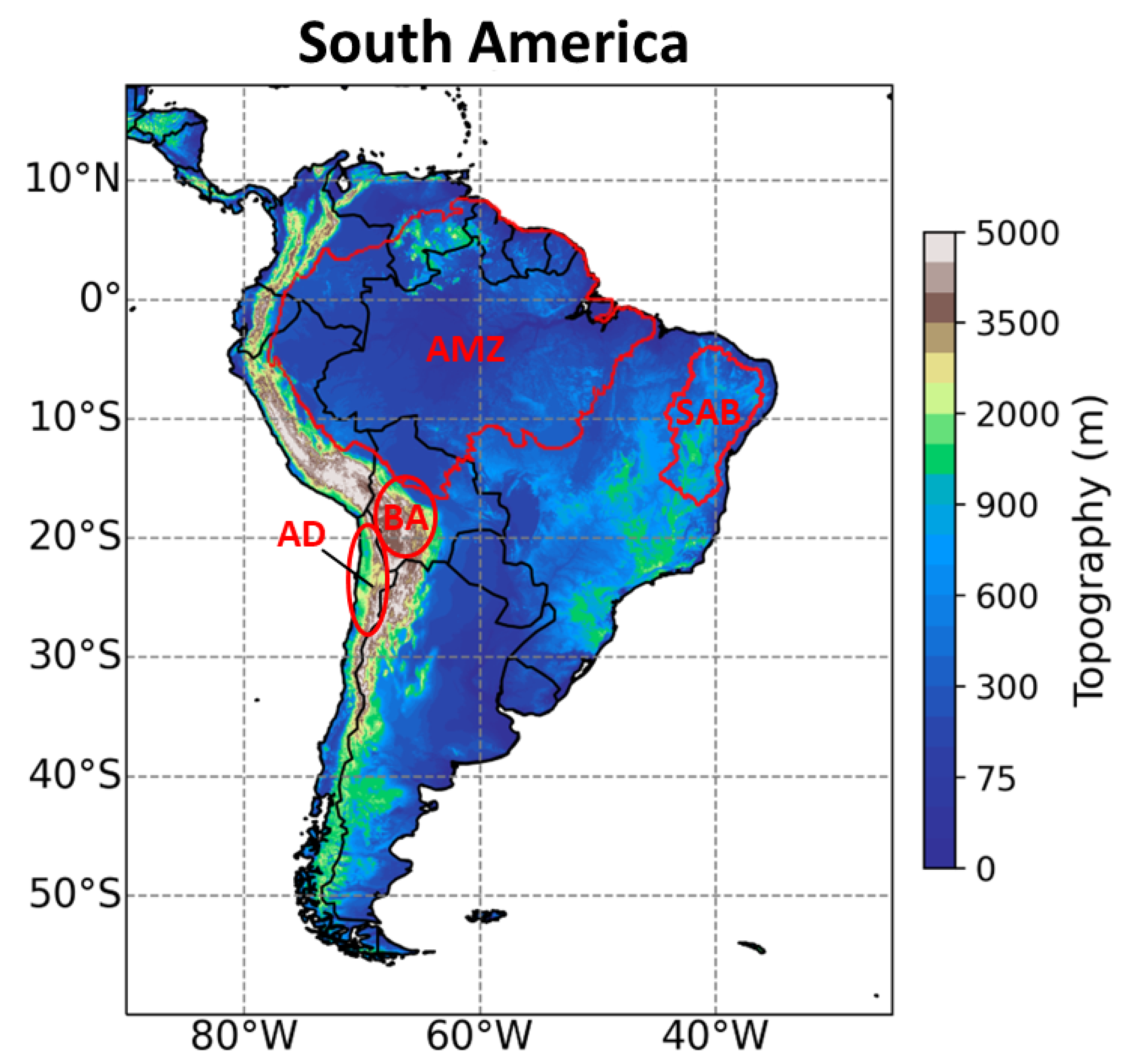
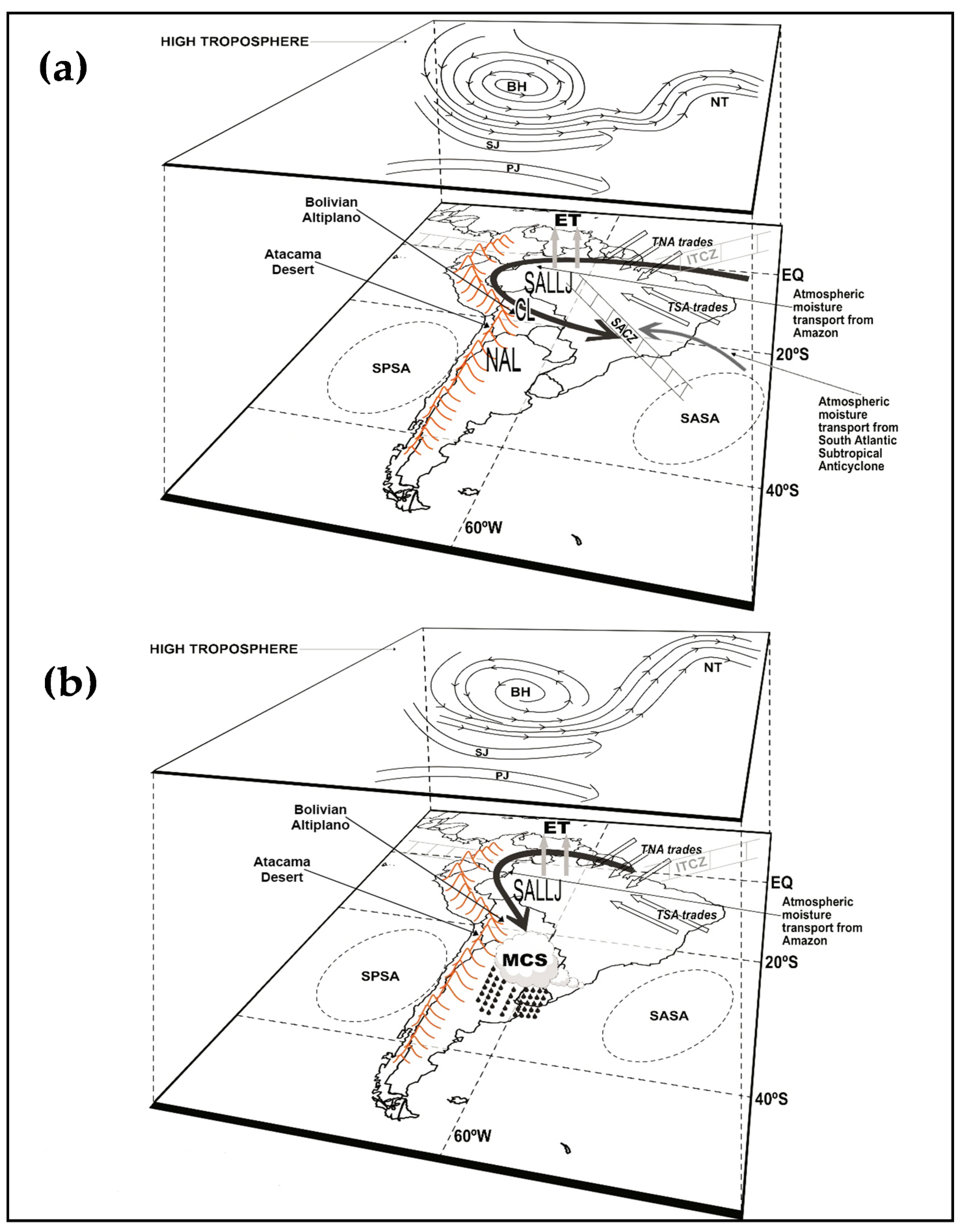
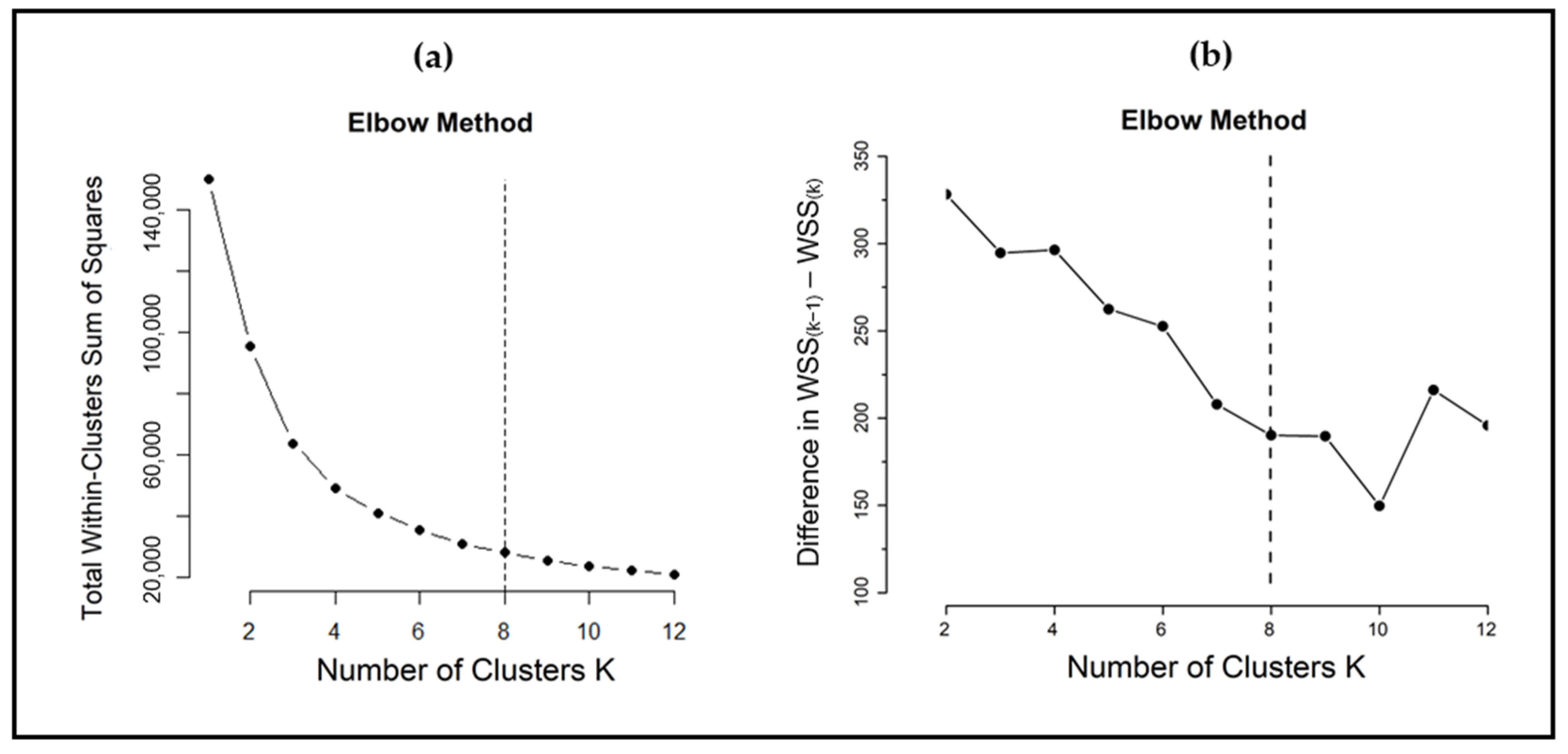


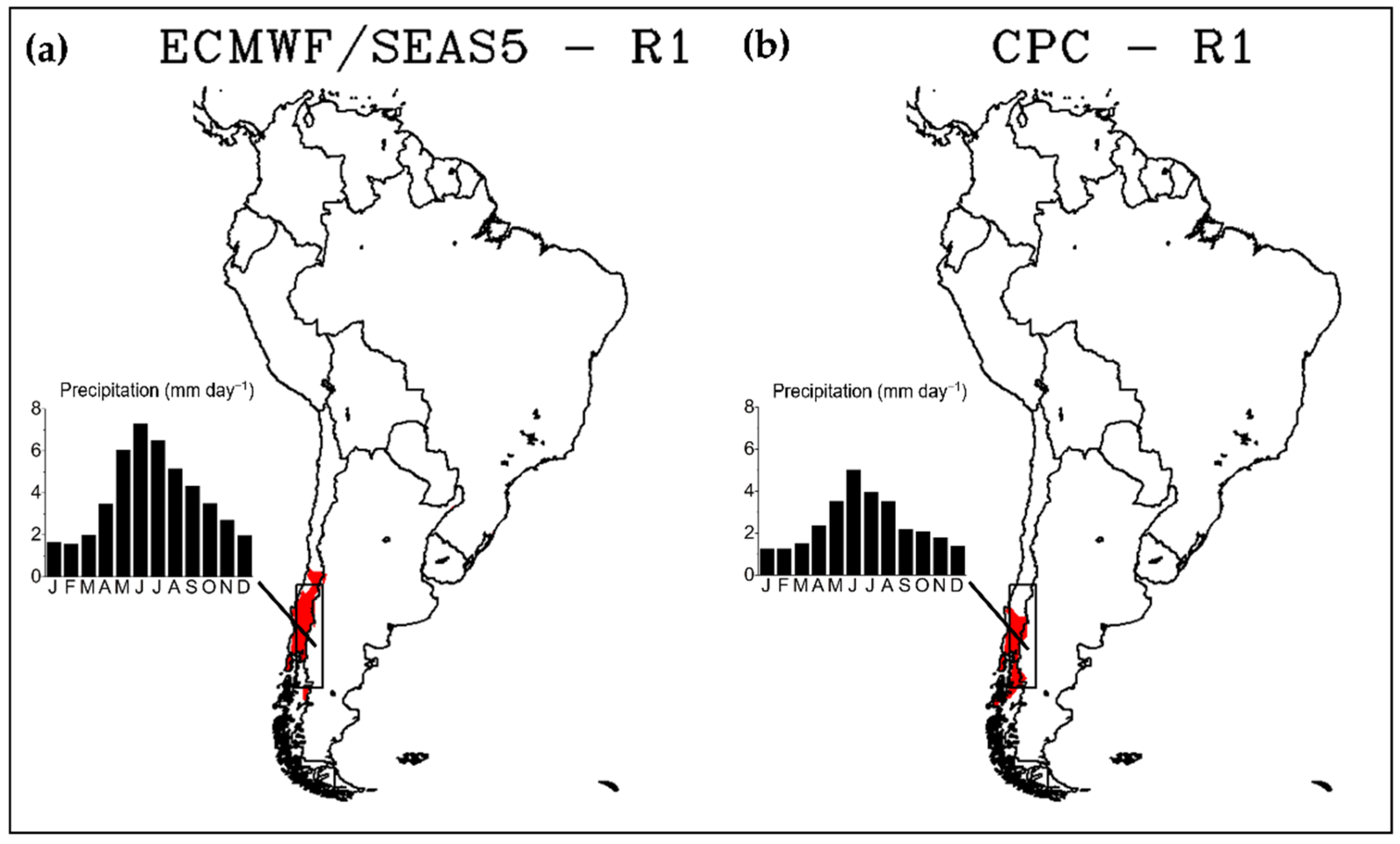
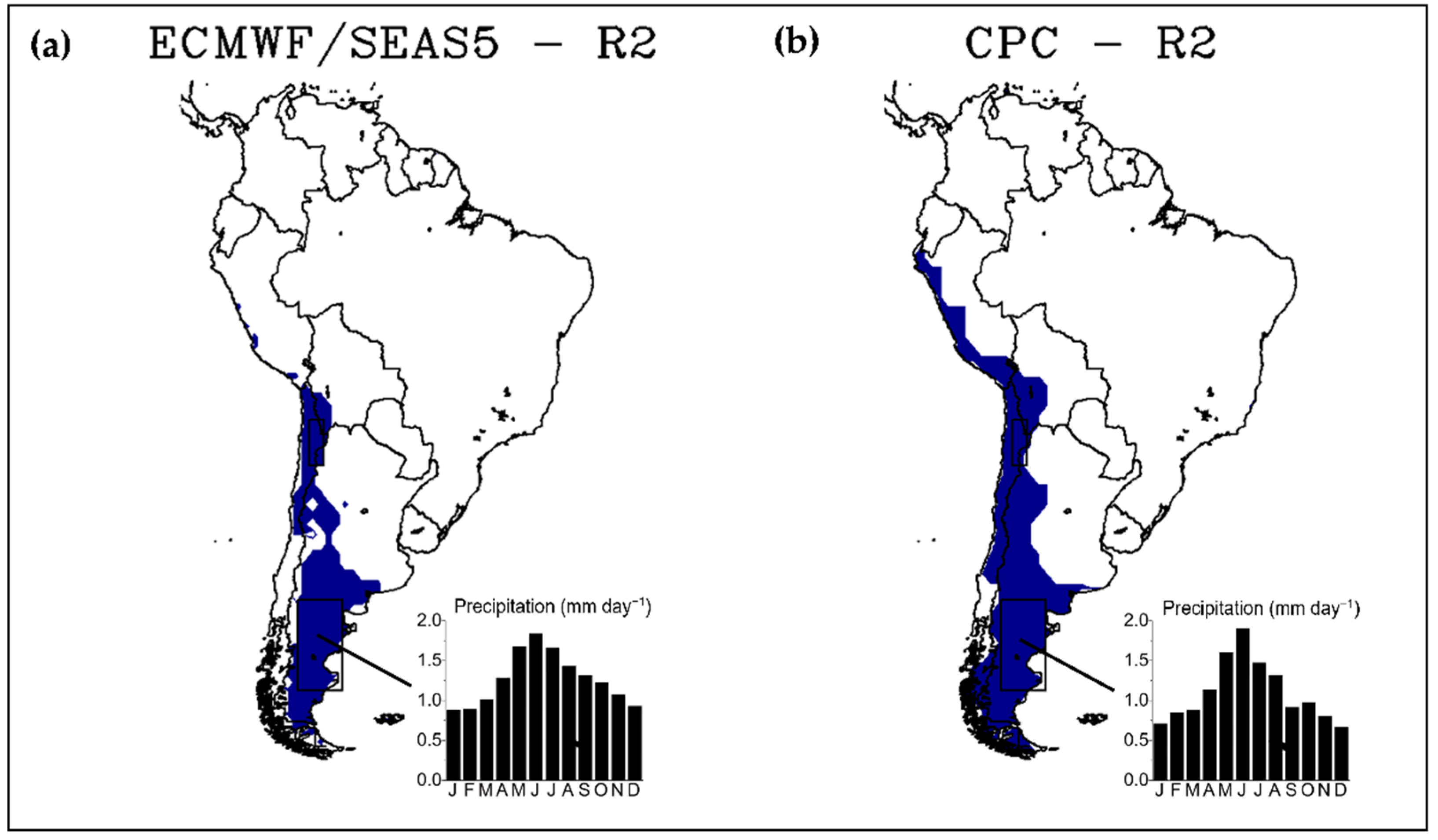
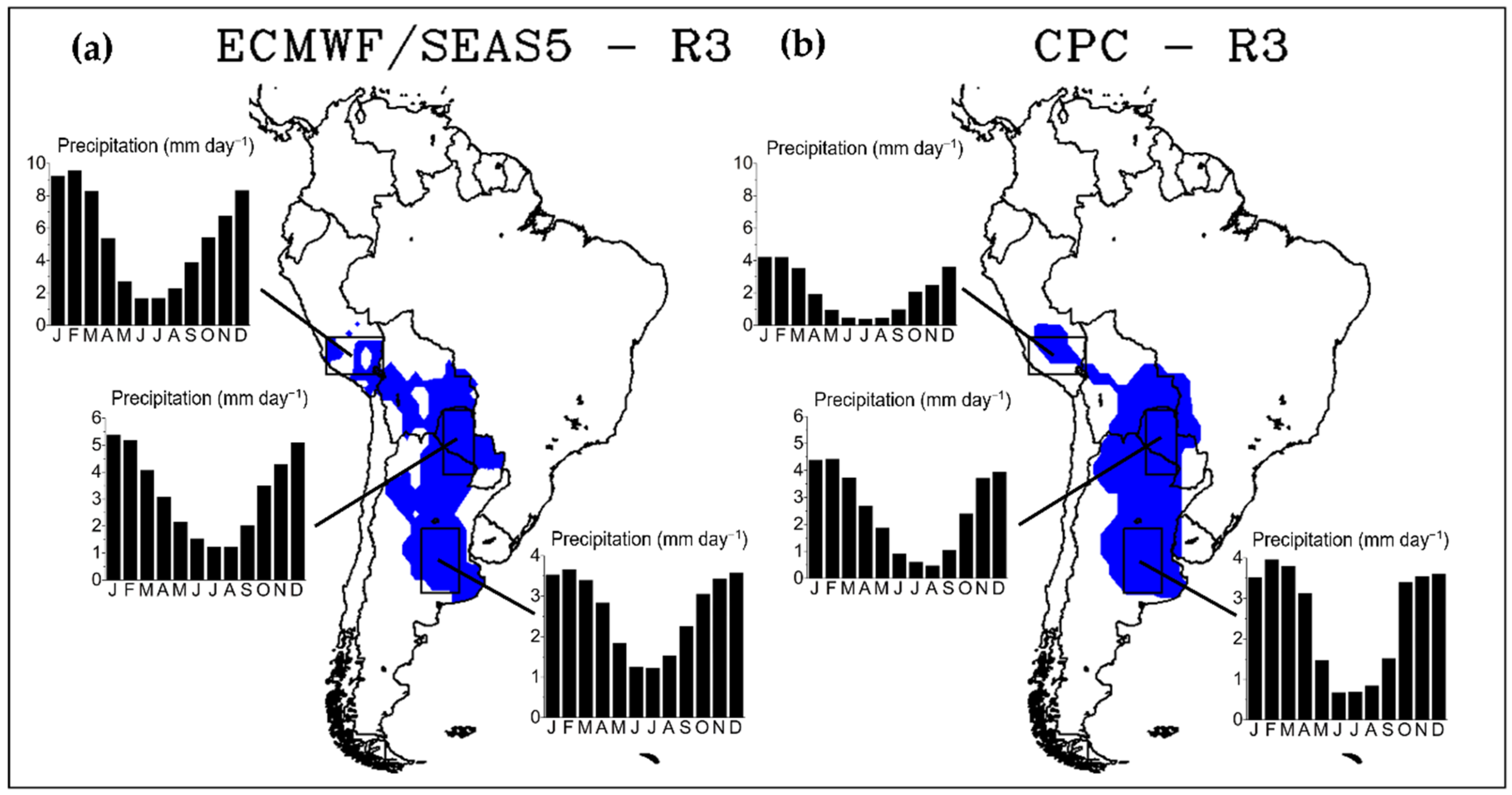
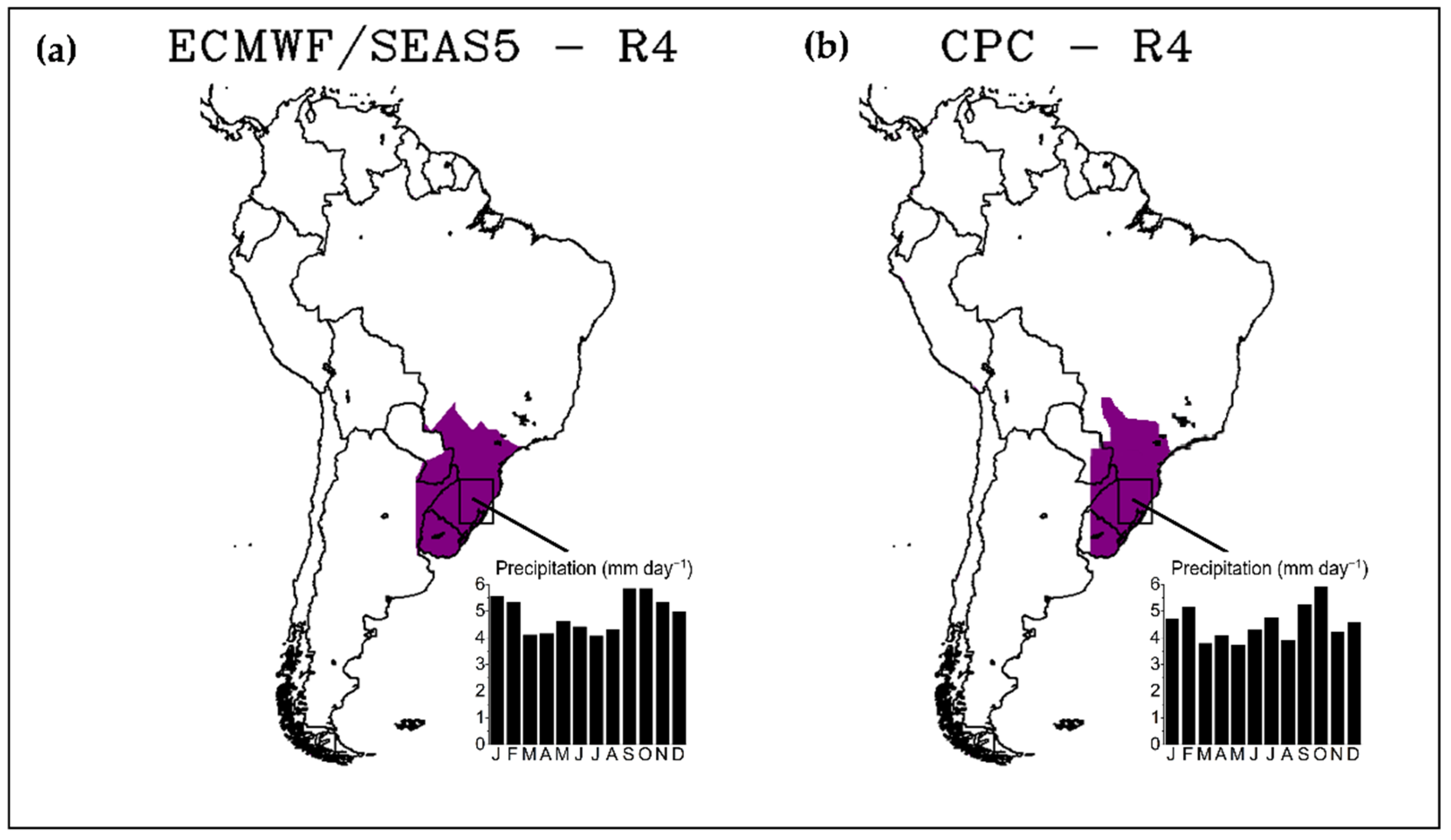

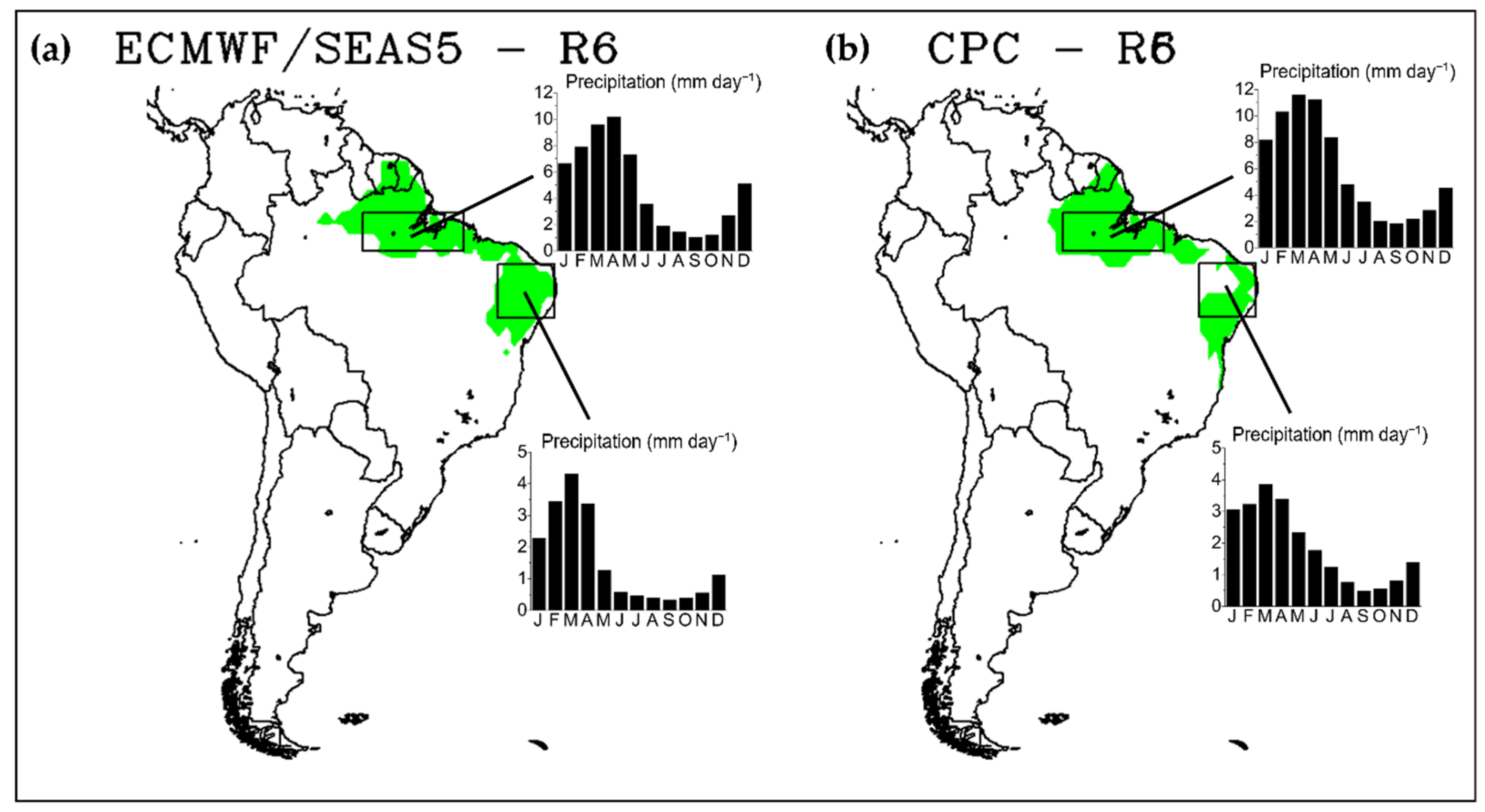

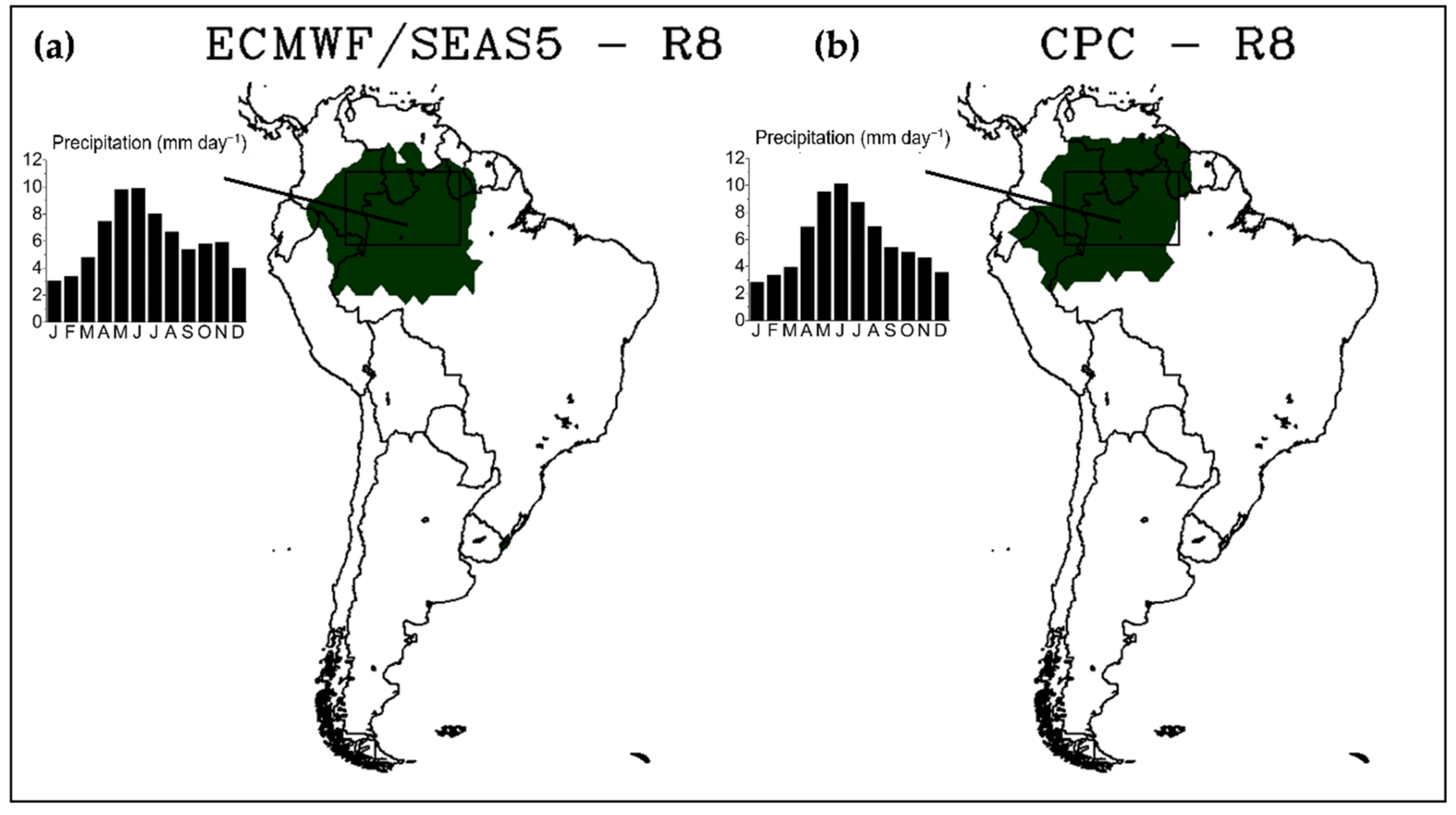
Publisher’s Note: MDPI stays neutral with regard to jurisdictional claims in published maps and institutional affiliations. |
© 2022 by the authors. Licensee MDPI, Basel, Switzerland. This article is an open access article distributed under the terms and conditions of the Creative Commons Attribution (CC BY) license (https://creativecommons.org/licenses/by/4.0/).
Share and Cite
Ferreira, G.W.S.; Reboita, M.S. A New Look into the South America Precipitation Regimes: Observation and Forecast. Atmosphere 2022, 13, 873. https://doi.org/10.3390/atmos13060873
Ferreira GWS, Reboita MS. A New Look into the South America Precipitation Regimes: Observation and Forecast. Atmosphere. 2022; 13(6):873. https://doi.org/10.3390/atmos13060873
Chicago/Turabian StyleFerreira, Glauber W. S., and Michelle S. Reboita. 2022. "A New Look into the South America Precipitation Regimes: Observation and Forecast" Atmosphere 13, no. 6: 873. https://doi.org/10.3390/atmos13060873
APA StyleFerreira, G. W. S., & Reboita, M. S. (2022). A New Look into the South America Precipitation Regimes: Observation and Forecast. Atmosphere, 13(6), 873. https://doi.org/10.3390/atmos13060873






